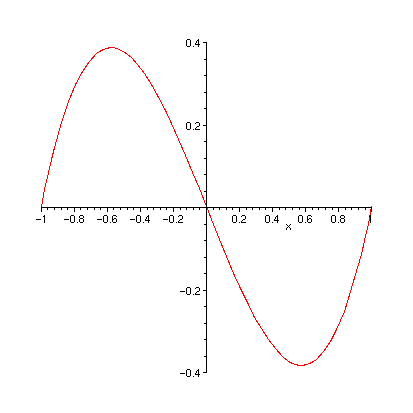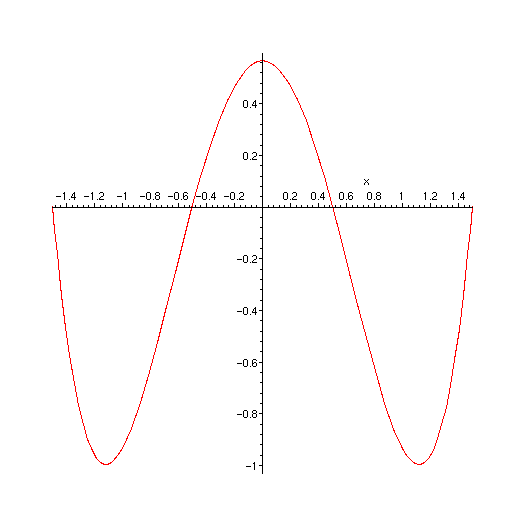> #==================================
> # Uebung 9 Aufgabe 4: Interpolation
> #=================================
> # Fehlerabschaetzungen
> #
> restart:
> fehler:=fe = D(D(f))(y)/2*(x-x[i])*(x[i+1]-x);
![]()
> fehler[ab]:=f < max(fabs(D(D(f))(y)))/2*h/2*h/2;
![]()
> d:=(D@@2)(sin);
![]()
> d[max]:=1;
![]()
> solve(1/8*h^2*d[max]<0.5e-4, h);
![]()
> h:=0.02;
![]()
> n:=evalf(Pi/2/h);
![]()
> # also 79 Abschnitte (78 Werte, da sin(0)=0 und sin(Pi/2)=1 bekannt)
> restart: # jetzt quadratisch
> fehler[ab]:=f < max(fabs(D(D(D(f)))(y)))/6*(x-x[i-1])*(x-x[i])*(x[i+1]-x);
![]()
> kp:=x->(x+h)*x*(x-h);
![]()
> plot(subs(h=1,kp(x)), x=-1..1);

> (D@@3)(sin);
![]()
> d[max]:=1;
![]()
> kps:=D(kp);
![]()
> xl:=solve(kps(x)=0, x);
![]()
> et:=simplify(kp(xl[2]));
![]()
> et:=evalf(et);
![]()
> fehler[ab]:=f < d[max]/6*et;
![]()
> xl:=solve(d[max]/6*et=0.5e-4, h);
![]()
> h:=xl[3];
![]()
> n:=evalf(Pi/2/h);
![]()
> # also 18 Abschnitte (17 Werte, da sin(0)=0 und sin(Pi/2)=1 bekannt)
> restart: # jetzt kubisch
>
fehler[ab]:=f < max(fabs((D@@4)(f)(y)))/24*(x-x[i-1])*(x-x[i])*(x[i+1]-x)*(x[i+2]-x);
![]()
> kp:=x->(x+3/2*h)*(x+1/2*h)*(x-1/2*h)*(x-3/2*h);
![]()
> plot(subs(h=1,kp(x)), x=-1.5..1.5);

> (D@@4)(sin);
![]()
> d[max]:=1;
![]()
> kps:=D(kp);
![]()
> xl:=solve(kps(x)=0, x);
![]()
> kp(0); evalf(kp(xl[2]));
![]()
![]()
> et:=h^4;
![]()
> fehler[ab]:=f < (d[max]/24*et);
![]()
> xl:=solve(d[max]/24*et=0.5e-4, h);
![]()
> h:=xl[4]; n:=evalf(Pi/2/h);
![]()
![]()
> # also 9 Abschnitte (8 Werte, da sin(0)=0 und sin(Pi/2)=1 bekannt)
>